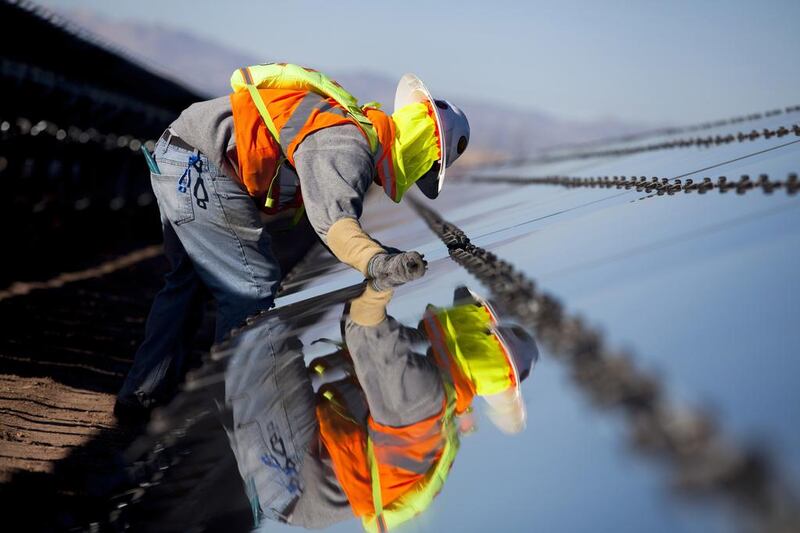California's commitment to renewable energy is evident through its legislation and ambitious spending.
However, as more cash is handed over to meet state targets, sceptics question whether a greener way of living is worth the price of so much green.
The current target for California’s renewables portfolio standard requires utilities to get 33 per cent of their electricity from renewable energy by 2020 – more than any other state in the United States.
Californian companies are well on their way to meeting this goal and may even exceed it but doing so has not been cheap.
According to a report by the legislative analyst’s office, California has spent a total of about US$4.4 billion on various programmes to support this target and other related goal, about a quarter of energy-related spending within the state over recent years.
Over the past 10 to 15 years, the state has doled out a combined total of about $15bn on more than a dozen major programmes intended to support the development of energy efficiency and alternative energy. According to the report, utility ratepayers funded the “vast majority” of such efforts.
Last year alone, the state spent $1.6bn. This year, California officials plan to spend nearly $15 million to build 10 hydrogen fuelling stations, despite the fact that there are few more than 200 hydrogen-powered vehicles in the state.
State agencies have invested in a variety of additional strategies to face climate change head on, including milk lorries that run on cow manure, ocean tide-fuelled power plants and artificial photosynthesis to power vehicles and buildings.
The costs for consumers are tucked away in obscure fees, such as small charges on electricity bills or vehicle licence plates. Three-dollar licence plate fees, for example, will help fund the hydrogen fuelling stations.
According to the public utilities commission, fees for various energy-related funds have added an estimated $24 annually to bills for the average residential electricity user and another $12 for gas customers.
State disbursements last year included $317m for renewable-energy projects, about $250m for advanced transportation projects and $44m for research grants, according to a legislative anaylst’s office report.
Furthermore, a programme that funds rebates and subsidies on products such as solar panels, industrial equipment and energy-efficient swimming-pool pumps has a price tag of $1bn a year.
While advocates praise the state’s efforts for battling climate change, others are expressing disapproval.
"Suddenly, you look up and there are literally hundreds of millions of dollars going into investments that produce marginal benefits," state Democrat senator Rod Wright, a member of the Energy, Utilities and Communications Committee, told The Los Angeles Times.
“You know the tale of Robin Hood? Well, this is robbing the ‘hood.’ You are taking from the poor people to give to rich people,” Mr Wright added.
Meanwhile, California programmes are increasing the state’s commitment to renewable and alternative energy.
According to Tiffany Roberts, the author of the report by the legislative analyst’s office, California is moving in the direction of spending $2.5bn per year on energy efficiency and alternative-energy programmes.
Last month, California adopted the nation’s first energy storage mandate, requiring the utility companies PG&E, Southern California Edison and San Diego Gas & Electric to bolster their capacity to store electricity, including renewable energy generated from solar and wind.
The utilities must collectively purchase an energy storage capacity target of 1.3 gigawatts, or 1,325 megawatts, by the end of 2020. That is estimated to be enough energy to supply about 1 million homes.
This is the largest target of its kind worldwide, setting to increase California’s installed energy storage capacity six fold.
“This decision represents an important first step in encouraging the storage market and supporting grid reliability,” says the head of the California public utilities commission (CPUC), Carla J Peterman.
“The CPUC’s decision to ensure storage capacity will increase the reliability of our electrical grid and optimise solar, wind and other renewable resources,” adds the assembly member Nancy Skinner.
Jerry Bloom, the chairman of Winston & Strawn’s energy, project development and finance practice group, has hinted toward public support for solar, wind and other renewable sources pushing California’s targets higher in the future.
“People are saying, ‘We don’t care there is a 33 per cent cap in California; we need more,’” Mr Bloom said at the recent Platts California Power and Gas Conference in San Francisco.
Mr Bloom added that even if the federal government did not extend tax credits that would expire at the end of the year, investments by major companies and projects would continue to bolster alternative and renewable energy.
Google and the investment firm KKR, for example, recently announced a $400m deal to develop six new solar power projects that will deliver electricity to utilities in California and Arizona.
The projects, under development by Recurrent Energy, should be up and running by January.
With so much support, it is no surprise Californian policymakers are considering a bill that would raise its renewable energy target to 51 per cent by 2030.
The bill, slated for a vote next year, would require investor-owned or publicly-owned electric utilities to come up with procurement strategies to reach this goal. It would also codify two existing state policies: an 80 per cent reduction in greenhouse gases by 2050 and a “loading order” for utilities to follow when buying more electricity, requiring them to first seek energy efficiency reductions and then renewable energy before relying on fossil fuels.
Despite all of the state’s efforts and spending, California ranked second for the third year in a row in the American council for an energy-efficient economy’s annual state energy efficiency scorecard.
Massachusetts beat California for top honours. The final scores between the two states were only one point apart, 42 to 41 out of a total possible score of 50.
The scorecard ranks states in various areas of energy-efficiency policy and practice, including mandated energy-use reduction targets for utilities, support for combined head and power projects and green building codes.
Massachusetts took the lead in the energy-use reduction category and displayed strong support for cogeneration. California had an edge over Massachusetts when it came to green building and appliance standards.
business@thenational.ae





